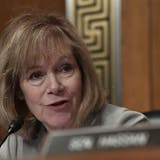For nearly eight years, the largest solar array in Minnesota has been an Xcel Energy facility in Chisago County that can power about 20,000 homes.
Soon, that lonely giant will be eclipsed.
Solar developers have proposed 16 colossal projects that would cover thousands of acres of rural Minnesota with glass and aluminum panels to capture energy from the sun.
Many are in the early stages of permitting, and others have significant obstacles. The projects nevertheless represent an unprecedented solar gold rush in a state that has largely relied on wind farms to make the transition to carbon-free energy.
In 2023, solar made up about 3% of electricity generated in a state that’s far from the Sun Belt. That number could more than quadruple by 2035, which would make solar the third largest share of power, behind wind and nuclear, according to one projection by the Minnesota Department of Commerce.
Private developers say there’s a confluence of factors driving the trend, such as federal tax credits that make mega projects cheaper. One huge draw is increasing demand from local electric utilities that are retiring coal plants to hit corporate goals as well as Minnesota’s target of having a 100% carbon-free grid by 2040.
“Minnesota continues to be a market that’s going to need a lot of renewable energy,” said Beth Soholt, executive director of Clean Grid Alliance, a St. Paul-based trade group for wind, solar and battery developers.
Projects in the pipeline
So far this year, six developers have filed the initial application for permits from the Minnesota Public Utilities Commission (PUC) for major solar projects, and a seventh company told the PUC it plans to seek permits soon.


